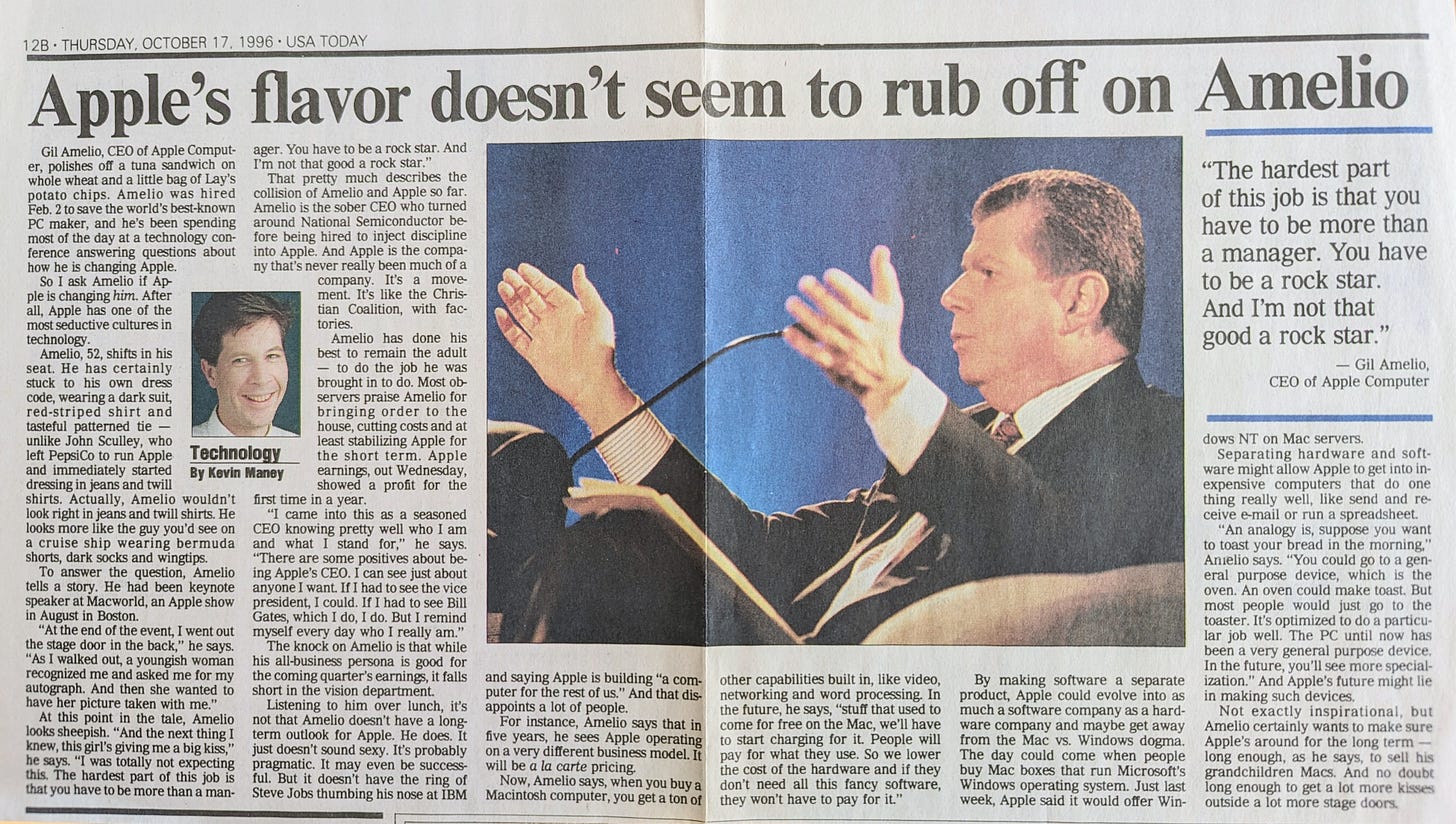That Time When Corporate CEOs Wanted to Run Dot-com Startups
...and the high-voltage headhunter who made it happen
You know what doesn’t happen anymore? High-ranking Fortune 500 executives don’t leave their companies to take a chance on running early-stage or challenged tech startups.
But a few decades ago, it was a thing, and much of it was powered by a headhunter named David Beirne…who I occasionally had lunch with and wrote about back in the nineties.
You could say that John Sculley was the OG of these corporate-leaping executives. Except that when he ditched the presidency of Pepsi to join Apple in 1983, Apple was neither early stage nor particularly troubled. One year after Sculley joined Apple, the company unveiled the Macintosh, vaulting Apple into legendary status.
Still, Sculley set a precedent. If he’d stayed at Pepsi, he probably would’ve become just another suit-wearing corporate CEO. His gig at Apple made him famous – even moreso after he forced out Steve Jobs in 1985. Certainly, other corporate executives noticed. Sculley, for a while at least, seemed to be having a lot more fun than they were while making a lot more money.
Yet the big trend didn’t catch hold until the arrival of the dot-com boom in the mid-1990s. Beirne helped set the trend in motion when he recruited Jim Barksdale to be CEO of Netscape, convincing Barksdale to leave his position as the No. 2 executive at wireless giant McCaw Cellular (later AT&T Wireless). Barksdale helped turn Marc Andreessen’s Mosaic web browser into a real business (although, as was common in the dot-com era, not one with profits), and took it public in 1995. Barksdale’s shares were instantly worth $420 million.
Then it started happening over and over. Beirne recruited William Razzouk out of Federal Express to be COO of AOL. He got Alex Mandl to quit as president of AT&T to become CEO of telecom upstart Teligent. He convinced Frank Ingari to leave established Lotus Development (maker of Lotus 1-2-3, a super-successful computer spreadsheet that was put out to pasture in 2013) to run a company called Shiva. Then he persuaded Jim Manzi, who was CEO of Lotus and sold that company to IBM, to become CEO of something called Industry.net.
All of which should give you a hint about why these corporate-to-startup leaps don’t happen much anymore: The companies mentioned above spiraled downward once the dot-com bubble burst in 2000. What turned out great for Sculley and Barksdale mostly turned sour for the rest of the batch. Mandl, who died in 2022, even had to repay a $12 million loan he got from Teligent.
The through-line of this story, though, is Beirne. Here’s how I described him in 1996, soon after he moved Manzi to Industry.net.
He’s a “Wizard of Oz” tornado, plucking people out of Kansas and dropping them into a strange land, a.k.a. the Internet industry. He is audacious. He is tall. He’s got about 1 million frequent-flier miles on United. He runs on two speeds: fast and blur.
Beirne was 32 at the time. He’d founded his search firm, Ramsey-Beirne, nine years earlier. As the dot-com craziness took hold, he saw an opportunity to create a unique kind of firm, focused on these high-profile recruitments from corporate America to dot-com land.
What happened to Beirne? In 1997, he joined Benchmark, one of the top venture capital firms. He left Benchmark in 2007 and now has his own business, X10 Capital, which does…something with pro athletes and investing. Check out the web site and see if you can figure out what X10 does.
Oh, and there was one more executive leap that ended up highlighting the cultural gap between big corporations and tech companies. At the start of the 1990s, Gil Amelio was CEO of chipmaking giant National Semiconductor. In 1996, he did a Sculley, quitting to become CEO of Apple. (This was not Beirne’s doing, btw.)
It was a terrible match. I sat down to interview Amelio at a tech conference in the fall of 1996. He showed up in a suit and tie, looking completely out of place among the dressed-down Silicon Valley types. At least Sculley ditched the formal wear for jeans. Though, as I wrote, “Amelio wouldn’t look right in jeans and twill shirts. He looks more like the guy you’d see on a cruise ship wearing Bermuda shorts, dark socks and wingtips.” I quoted him in the column saying, “The hardest part of this job is that you have to be more than a manager. You have to be a rock star. And I’m not that good a rock star.”
Amelio brought some business discipline to Apple, and he gets credit for buying Steve Jobs’ NeXT Computer, which brought Jobs back to Apple in February 1997. Then, in July of that year, Jobs got the board to boot out Amelio.
Any big Fortune 500 execs want to join a startup now?
—
My original USA Today column about David Beirne is not available online. However, my columns often ran in other Gannett newspapers, so below is a clip of it from The Jackson Sun in Jackson, Tenn. It ran on February 11, 1996.
My USA Today column about Gil Amelio is also not available online, but I have the original clipping, from October 17, 1996. I pasted an image below.






